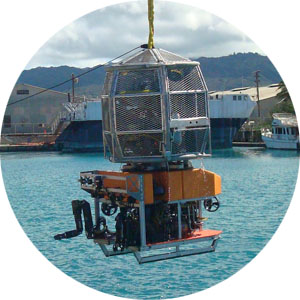Remotely Operated Vehicle(s)

Luʻukai H6000 ROV
SOEST's new 6000 meter-capable remotely operated vehicle (ROV), Luʻukai (Hawaiian for "sea diver"), was designed and constructed by Deep Ocean Exploration and Research(DOER). The Luʻukai will allow investigators to access the seabed of the majority of the Pacific Ocean and is the only vehicle currently operational in the existing fleet of UH manned, remotely operated, and autonomous underwater vehicles. Designed for maximum maneuverability and mission flexibility, the she has the ability to collect specimens; characterize substrates; capture video and still images of activities and surveys; monitor water column properties; install, connect and test seafloor equipment; and perform other specialized tasks. For more information about the Luʻukai, contact the UH Marine Center.
General Data
- Size: 78.5" L x 55" W x 58: H
(including skids)
- Weight: not to exceed 3000 lbs (1360
kg)
- Payload: 150 lbs (68 kg) minimum
Depth Rating: 6000 m
- Hydraulics: 2800 psi @ 12.5 GPM
- Power: 25 shaft hp; 7 thrusters total
(4 horizontal, 3 vertical) - 175 lb thrust each
- Lights: 4 LED lights, 2 dimmable
- Two manipulator arms: Schilling Orion
7P and Sea Mantis 5 function proportional
- Falmouth Scientific MicroCTD
(conductivity, temperature, depth)
- Novatech xenon strobe locating beacon
- Collision avoidance sonar
- 5 mW red lasers (housing allows
exchange for lasers of different color or power)
- Fixed focus video cameras: Deepsea
Power and Light Nano cameras and Multi Seacams (number
TBD)
- Zoom video cameras:
- 1 Insite Pacific mini Zeus High Definition (HD)
camera
- 1 Standard Definition (SD) camera TBD
- Science manifold providing spare bulkhead
connections with power and communication links
Construction
- Deep Ocean Exploration and Research
(DOER), Alameda, CA
Equipment
- High Definition (HD) video camera: 1
Insite Pacific mini Zeus on pan and tilt mount with
zoom and focus control.
- Falmouth Scientific MicroCTD
(conductivity, temperature, depth) Science manifold
providing spare bulkhead connections with power &
communication links
- 12, 24 and 48 VDC, up to 150 W each.
- Two serial channels (RS-232 and RS-485) and one
Ethernet (1 GB/s)
- One spare fiber channel for custom applications
- Closing specimen basket
- 5 mW red lasers aligned with 15 cm separation.
Housing allows exchange for lasers of different color
or power.
Support Equipment
- Control van: 20 ft; with graphical user
interface-based control system: controls all ROV
functions, provides pilot with system status on
vehicle components, and allows for user-determined
visual and audible alarm thresholds. Accommodates 3
ROV operators and several scientific observers.
- Workshop van: 20 ft; for vehicle maintenance and
spare supplies; power distribution unit; space for ROV
shipping
- Umbilical: Standard UNOLS 0.681
electro-fiber-mechanical cable transmits power, and
provides data and communications links with vehicle
- Neutrally-buoyant tether: Tether Management System
(TMS) with capstan and slip ring winch drum for
managing tether. TMS is deployed via the umbilical and
is equipped with altimeter, compass, cameras, lights
and USBL responder link. TMS is fitted with 110m of
tether and can accommodate up to 200m.
- Telemetry: 1 GB Ethernet; vehicle telemetry and HD
video will be transmitted via a single fiber (this can
support a variety of sensors including new-generation
imaging multi-beams sonar). Spare fiber available for
custom applications.
- Underwater navigation: Sonardyne Ranger 2 ultrashort
baseline (USBL) navigation system to 6000m; TrackLink
5000 USBL available for shallower operations.
- Capable of being deployed from UH research vessels
R/V KM and R/V KOK
RCV-150 ROV
The RCV-150 ROV was a remotely operated
robotic submersible that was operated by HURL between
1998 and 2011. It was piloted from a shipboard station,
receiving power and commands from the surface control
console via a steel armored electro-mechanical fiber
optical cable. The vehicle could operate to depths of
914 meters (3000 ft). It was equipped with two color
video cameras with lights and a CTD which sent data
directly up the wire. RCV-150 was primarily
used as a video survey tool that could acquire extremely
close-up views because of its small size and
maneuverability.
[ Top of page ]
|

